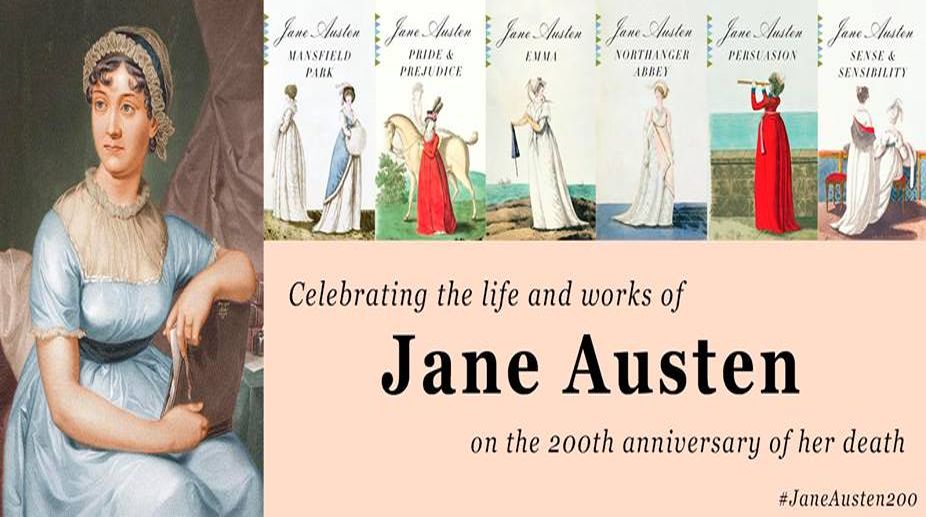I do make mistakes since I am also human and not God: PM Modi
Prime Minister Narendra Modi has said he does make mistakes like everyone else as he is also a human being and not God, but asserted that he would never do anything with ill intention.

(Photo: Facebook)
Jane Austen was a great novelist of the early 19th century. Born on 16 December 1775, she was the second daughter of The Reverend George Austen and his wife, Cassandra. Jane and her sister, Cassandra had six brothers.
She spent a lot of her life in the beautiful English county of Hampshire and the lovely countryside and rolling dales were a source of inspiration for her novels.
Advertisement
Austen died on 18 July, 1817 possibly from Hodgkin’s lymphoma at the age of 41 and therefore this year marks the 200th anniversary of her death. Jane Austen’s House Museum and other Organizations, across England, will celebrate the author’s creativity and talent.
Advertisement
Before one reflects on Austen’s notable books, it will be relevant to pause and digress to another literary family of three sisters, who also lived in the 19th century. Charlotte, Emily and Anne Bronte comprised the three sisters, and the similarity with Austen was that both their fathers served the church. Like Austen, the Brontes were not readily accepted into England’s literary world.
That compelled them to publish their writing under male pseudonyms. It was Charlotte Bronte’s Jane Eyre, which first witnessed success, similar to Austen’s Pride and Prejudice. Equally interesting, as a comparison of Austen and the Bronte sisters, is that they initially wrote narratives to read out to their parents and siblings, at home. That was a prelude to their respective literary careers.
People were prone to scrutinising the manuscripts of these women writers with scorn or even condescension. Their stories revolved around love and matrimony during an era when finding an eligible man for a sheltered lady was a challenge, often fraught with difficulties, when the man could also be swayed and influenced by another woman, causing heartbreak to the first suitor.
It was a time when marriage swiftly became the ultimate ambition of women. Austen reflected the minds of women, with these words, “A lady’s imagination is very rapid; it jumps from admiration to love, from love to matrimony, in a moment.” Pride and Prejudice, first published in 1813, is a humourous story of love and life among the English gentility during the Georgian era.
Mr Bennet is an English gentleman, living in Herefordshire, with his overbearing wife.The Bennet’s five daughters, from the beautiful Jane to the wild Lydia, are integral to the storyline, which hinges on Jane and her sister, Elizabeth’s matrimonial plans. The plot signifies an undertone of urgency — Mr Bennet’s Longbourn estate, where the family live is entailed, which means none of the five sisters can inherit it.
Mrs Bennet has no fortune, so it is vital that at least one of the sisters marries well in order to support the others after Mr Bennet’s death. The novel, thus, circles around the necessity of marrying for love, and not simply for money. The words of Austen are manifest with relevance, “A single man in possession of a good fortune must be in want of a wife.” Austen’s book, Emma, published in 1815, explores the difficulties of genteel women in England’s Georgian-Regency and creates a wonderful comedy among the characters.
Unlike Pride and Prejudice, she introduces the title character as Emma Woodhouse, a clever and rich lady. This reads as a contrast to Pride and Prejudice, where the principal characMatters familial This year marks the 200th death anniversary of novelist Jane Austen ters are Jane and Elizabeth. Emma is a spoiled and headstrong person and underestimates her own matchmaking abilities.
She ignores the dangers of meddling in other people’s lives and her obstinacy and wild imagination often lead her astray. Her effort to try and marry off her friend Harriet to Mr Elton, the local vicar, is not a smooth sailing plan. Harriet had already proposed to Robert Martin, a respectable farmer, which Emma advised Harriet to cancel. Mr Elton, a social climber, thinks Emma is in love with him.
So when he proposes to Emma, there is a chaotic chain of developments. The story concludes with Emma accepting Mr Knightley’s proposal; he has been Emma’s well wisher throughout, which Emma did not realise till the end. In Mansfield Park, published in 1814, Austen narrates the lives of the upper class. A young girl, Fanny Price, comes to live with her wealthy uncle and aunt.
Fanny’s family, in contrast, is quite poor. She is somewhat isolated in a different social class. Despite distinctions in the social hierarchy at Mansfield Park, Fanny marries to live happily ever after. Until her books were published, Austen received no income and depended on pocket money from her father. Sandra Tupper, curator of an exhibition, asserts, “Her whole world was her family.”
Two hundred years later, her brilliance as a writer has been acknowledged differently. An image of Austen is to appear on 10 Pound notes and on two Pound coins in Britain.
Advertisement